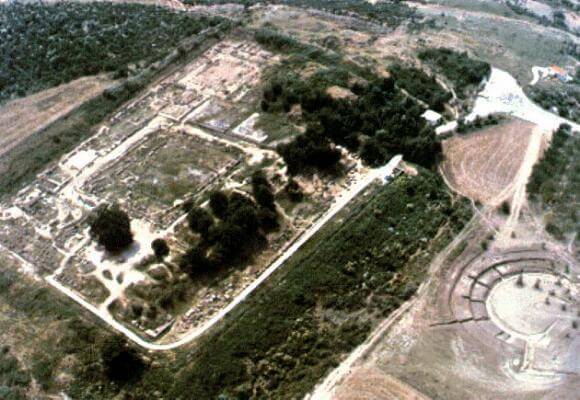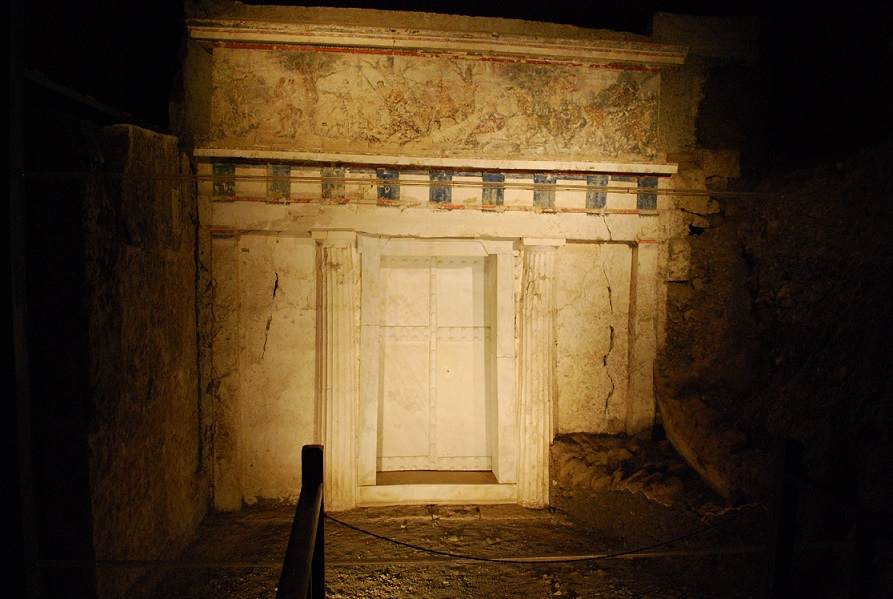
Vergina (Aigai)

Brief Overview
Vergina represents exceptional testimony to a significant development in European civilization, at the transition from the classical city-state to the imperial structure of the Hellenistic and Roman periods.
This is vividly demonstrated in particular by the remarkable series of royal tombs and their rich contents. The paintings found at Vergina are of extraordinarily high quality and historical importance.
The ancient city in the northern foothills of the Pierian range is the capital of the kingdom of Lower Macedonia, Aigai, traditionally founded by Perdiccas I when the Macedonians of the Argive spread northwards over the plain of Emathia.
This region was already settled in the early Bronze Age (3rd millennium BC), as evidenced by a tumulus (grave-mound) near the river Haliakmon. The wealth and density of over 300 grave-mounds in the Cemetery of the Tumuli testifies to the importance of Aigai in the early Iron Age (1100-700 BC).
As the capital of the Macedonian kingdom and site of the royal court, Aigai was the most important urban centre in the region throughout the archaic period (800-500 BC) and the following century.
The grave-goods in a series of tombs dating from the 6th and 5th centuries BC demonstrate commercial and cultural links with Greek centres of eastern lonia and the south.
At the end of the 5th century, Archelaus brought to his court artists, poets and philosophers from all over the Greek world.
Although the administrative centre was transferred to Pella in the 4th century BC, Aigai retained its role as the sacred city of the Macedonian kingdom, the site of the traditional cult centres, and the royal tombs. It was here in 336 BC that Philip II was assassinated in the theatre and Alexander the Great was proclaimed king.
The bitter struggles between the heirs of Alexander, the Diadochoi, in the 3rd century adversely affected the city, and it was further slighted after the overthrow of the Macedonian kingdom by the Romans in 168 BC.
Nevertheless, it was rebuilt and survived into early imperial times. However, between the 2nd and 5th centuries AD the population progressively moved down from the foothills of the Pierian range to the plain, so that all that remained was a small settlement whose name, Palatitsia (palace), alone indicated its former importance.

In Detail
Vergina - a recent find
Vergina is one of those finds which archaeologists dream about - a well preserved discovery, proven association with a famous historical person, and real treasure!
In 1977 the find was made by Professor Manolis Andronikos, who continued the excavations. Vergina is the modern village, and following the discovery the site was identified as Aigai, the ancient capital of the Macedonian kings, together with its cemetery.
And the reason for all this enthusiasm? A tumulus measuring about 110m wide by 13m high turned out to cover some tombs. Not just any old tombs, either. One of them was identified as that of Philip II of Macedon, the father of Alexander the Great. Another is thought to belong to Alexander IV, the son of Alexander the Great.
Unique treasures
But it wasn't just the graves themselves which excited the archaeologists. It was the artifacts contained in them, together with wall paintings.
In order to preserve these priceless treasures an underground building was constructed in 1993 to protect the royal tombs. It also maintains the temperature and humidity at suitable levels to preserve the wall paintings.
As you approach you don't even realise it's a building, because it looks just like a normal earth tumulus. The authorities have come up with an excellent solution to both preserve the treasures found in the royal tombs and allow public access. Apart from the sepulchral monuments themselves, there is an open area of 1,000 sq.m., where the finds from the tombs are displayed in showcases.
What you can see
Some grave stelai were found, and you can see these together with artifacts used by ordinary people of Philip's time. These show the different lifestyles of common folk and royalty.
The first tomb you come to is a large Macedonian tomb, almost contemporary with the others, which was found desecrated and completely destroyed.
Next is the Heroon, a building which was intended for the cult of the dead kings. This grave is important because it has a wall painting of the rape of Persephone by Pluto. Wall paintings rarely survive, and to find one in such a comparatively good state of preservation is remarkable.
The most important tomb is that of Philip II, the father of Alexander the Great. The facade has the form of a Doric temple, with a marble door, above which are stylised triglyphs and metopes. Above the Doric frieze is an Ionic frieze which is another painting of a hunting scene. Three horsemen and seven men on foot pursue a lion, deer, and boar. One of the men is mature and bearded, and experts think this is Philip himself. Another of the men is thought to be Alexander the Great.
This hunting scene and the Rape of Persephone are the only surviving examples we have of ancient Greek painting. They are thought to be the work of Philoxenes and Nikomachos.
In the burial chamber of Philip they found a marble sarcophagus, a gold larnax containing the ashes of the dead king and his crown inside it. There were weapons, a wooden mortuary couch which was decorated with gold, glass, and ivory.
After Philip was assassinated, his wife Cleopatra was also killed. In the antechamber of his tomb a larnax was found, with a royal diadem, a marble sarcophagus, and another wood couch. It's thought that this is where she was buried.
The last tomb is thought to be that of Alexander IV, the son of Alexander the Great, and is very similar to Philip's. Other items such as weapons, grave goods, vases, and another couch.
All these items are on display, which is why a visit to Vergina - ancient Aigai - is well worth considering.
[1]
Official Website and Map
Further Sources
[1] "Visit Ancient Greece"
"History Of Macedonia"
"Ancient Greek History"
"Aigai"
Our Mobile Application
Check out Our Mobile Application "Ancient Greece Reloaded"


